- Polynemoidei
-
Fadenflosser Systematik Klasse: Strahlenflosser (Actinopterygii) Teilklasse: Echte Knochenfische (Teleostei) Überordnung: Stachelflosser (Acanthopterygii) Ordnung: Barschartige (Perciformes) Unterordnung: Echte Barsche (Percoidei) Familie: Fadenflosser Wissenschaftlicher Name Polynemidae Die Familie der Fadenflosser (Polynemidae) ist eine Gruppe der Barschartigen. Ihren Namen haben die Tiere von ihren seltsamen Brustflossen, deren unterer Teil aus vier bis sieben fadenförmigen langen Strahlen besteht. Wahrscheinlich können die Polynemidae mit Sinnesorganen auf den Fäden Beute aufspüren, wenn sie diese über den Boden schleifen lassen. Die 33 Arten in sieben Gattungen leben in weltweit in tropischen und subtropischen Regionen, im flachen küstennahen Meer und im Brackwasser, immer über sandigen und schlammigen Weichböden. Einige Arten wandern auch in die Flüsse.
Systematik
Es gibt acht Gattungen und ca. 40 Arten.
- Eleutheronema
- Filimanus
- Filimanus heptadactyla (Cuvier, 1829).
- Filimanus hexanema (Cuvier, 1829).
- Filimanus perplexa Feltes, 1991.
- Filimanus sealei (Jordan & Richardson, 1910).
- Filimanus similis Feltes, 1991.
- Filimanus xanthonema (Valenciennes, 1831).
- Galeoides
- Galeoides decadactylus (Bloch, 1795).
- Leptomelanosoma
- Leptomelanosoma indicum (Shaw, 1804).
- Parapolynemus
- Parapolynemus verekeri (Saville-Kent, 1889).
- Pentanemus
- Pentanemus quinquarius (Linnaeus, 1758).
- Polydactylus
- Polydactylus approximans (Lay & Bennett, 1839).
- Polydactylus bifurcus Motomura, Kimura & Iwatsuki, 2001.
- Polydactylus longipes Motomura, Okamoto & Iwatsuki, 2001.
- Polydactylus macrochir (Günther, 1867).
- Polydactylus macrophthalmus (Bleeker, 1858).
- Polydactylus malagasyensis Motomura & Iwatsuki, 2001.
- Polydactylus microstomus (Bleeker, 1851).
- Polydactylus mullani (Hora, 1926).
- Polydactylus multiradiatus (Günther, 1860).
- Polydactylus nigripinnis Munro, 1964.
- Polydactylus octonemus (Girard, 1858).
- Polydactylus oligodon (Günther, 1860).
- Polydactylus opercularis Seale & Bean, 1907.
- Polydactylus persicus Motomura & Iwatsuki, 2001.
- Polydactylus plebeius (Broussonet, 1782).
- Polydactylus quadrifilis (Cuvier, 1829).
- Polydactylus sexfilis (Valenciennes, 1831).
- Polydactylus sextarius (Bloch & Schneider, 1801).
- Polydactylus siamensis Motomura, Iwatsuki & Yoshino, 2001.
- Polydactylus virginicus (Linnaeus, 1758).
- Polynemus
Literatur
- Joseph S. Nelson, Fishes of the World, John Wiley & Sons, 2006, ISBN 0-471-25031-7
- Roland J. McKay: Threadfins of the world (Family Polynemidae). An annotated and illustrated catalogue of polynemid species known to date. FAO Species Catalogue for Fishery Purposes. No. 3. FAO Rom 2004. (PDF)
Weblinks
Wikimedia Foundation.


